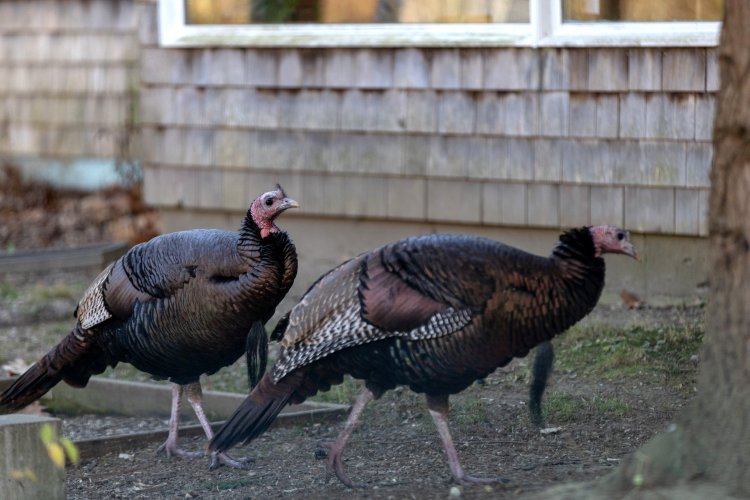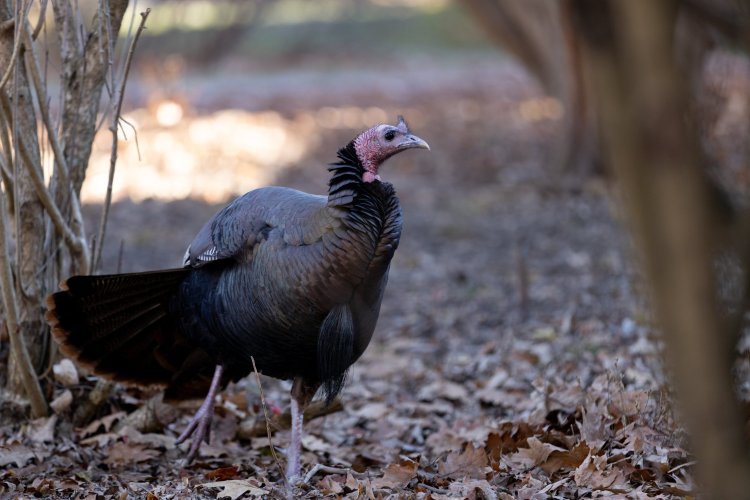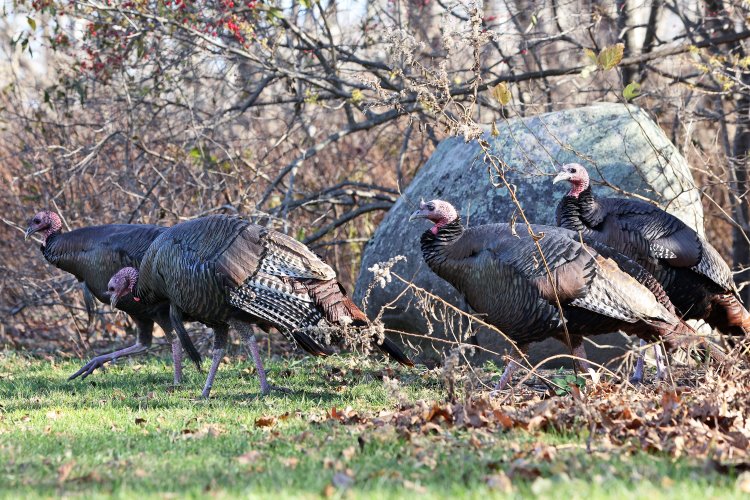
A flock of wild turkeys forage at Gilsland Farm in Falmouth on Tuesday. Ben McCanna/Staff Photographer
Visitors to Maine Audubon’s Gilsland Farm in Falmouth are often welcomed near their cars – not by staff or volunteers – but by little dinosaur-like greeters. The two-legged, brown-feathered creatures with long necks and bright red wattles forage for food along the trails and raise their young in the meadows.
Without the threat of hunting in this protected reserve, wild turkeys seem undisturbed by the people they encounter as they go about their turkey business.
As Thanksgiving approaches, these may be the safest turkeys in Maine. And they know it, said Andrew Kapinos, a Maine Audubon field naturalist who leads educational bird walks at Gilsland Farm.
“They very clearly know it’s not a place that they’re going to be hunted,” he said. “I think turkeys come here from all around the area.”
These days, it’s not uncommon to see rafters of turkeys parading through suburban neighborhoods, holding up traffic as they cross roads or hanging out in fields. In southern Maine, it often feels like they’re everywhere.
But it wasn’t always this way.
Hundreds of years ago, turkeys existed in significant numbers in York and Cumberland counties – and there may have been some eastward to Hancock County. Indigenous artifacts indicate they lived in coastal areas and potentially up to the Bangor area, said Kelsey Sullivan, a state game bird biologist who monitors Maine’s turkey population.
A combination of unregulated hunting and the clearing of their forest habitat for farmland was devastating to the turkey population. By the late 1800s, they were extirpated, or locally extinct, Sullivan said.
Though the population has rebounded exponentially, it still faces threats – from passing cars on the highway to “forever chemicals” that have polluted their environment.
WHERE DID ALL THESE TURKEYS COME FROM?
The Maine Department of Inland Fisheries and Game – now the Department of Inland Fisheries and Wildlife – tried to reintroduce turkeys to Maine starting in 1942, but none of its attempts were successful until the late 1970s.
In 1977 and 1978, the department picked up 41 wild turkeys in Vermont and released them in the towns of York and Eliot. In the spring of 1982, 33 turkeys from the growing York County population were trapped and taken up to Waldo County. Five years later, another 70 turkeys were brought in from Connecticut, according to the department.
By this time, many farms across the region had long been abandoned, allowing thousands of acres of farmland to revert to the wooded habitat turkeys need to survive and thrive.
And they have thrived – spreading far beyond their historical range.


Two wild turkeys forage near the Maine Audubon offices at Gilsland Farm in Falmouth on Nov. 14. Brianna Soukup/Staff Photographer
The estimated population in spring is now between 70,000 and 80,000 and grows by two or three times by fall, Sullivan said.
Wild turkeys can now be found in all 16 counties and up into New Brunswick and Quebec, though the highest density is still in coastal southern Maine. Turkeys traveled into Maine’s deep woods along power and gas line corridors, Sullivan said, although there still is not an overabundance of them in the northern woods, where snow depth is a challenge.
Kapinos said the abundance of these birds is a great example of how to take meaningful action to reintroduce a species to a place where humans were the cause of their demise.
“It’s a conservation success story that’s in everyone’s yard,” he said.
WHAT’S SO SPECIAL ABOUT ALL THESE TURKEYS?
Some may say turkeys aren’t the prettiest birds, but those who study them say the highly adaptable creatures are pretty fascinating.
“They have really cool social structures. They’re highly social birds,” said Kapinos, who enjoys seeing them at Gilsland Farm when he’s leading bird walks.
At the beginning of their lives, turkeys follow their mother around in the meadows, learning what to eat and where it is safe to go. At the farm, “you’ll hear the mother clucking to the young to sort of keep them in the same space and maybe warn them if there’s a predator nearby,” Kapinos said.


Two wild turkeys forage near the Maine Audubon offices at Gilsland Farm in Falmouth on Thursday, Nov. 14. Brianna Soukup/Staff Photographer
As adults, turkeys tend to group up by sex throughout most of the year. In February or March, they start reforming into mating groups that include a few dominant males, who are usually siblings, and a bunch of females and non-breeding males. Soon after, the males start their elaborate displays of strutting and gobbling to attract as many hens as they can. They fan out their tail feathers and parade around, not unlike the more colorful and majestic mating dance of peacocks.
“It’s one of those signs we’re getting closer to spring,” Kapinos said.
After breeding, hens confine themselves to nesting in shallow depressions on the ground at the base of a tree, under at tangle of brush or in dense herbaceous cover. Eggs are incubated for 26 to 28 days before hatching. Young turkeys, called poults, usually leave the nest the day they hatch. Hens and their broods frequent fields and forests to search for insects and other food.
“It’s so much fun to watch them forage,” Kapinos said. “They will spend 30 minutes eating acorns and grubs under an oak tree, then go to the feeders and out to the fields. They’re super, super smart and can pick out these little imperceptible morsels of food in leaf litter.”
Sullivan said some people may think turkeys are dumb, but biologists measure their intelligence based on how they survive and how in touch they are with their environment.
“Turkeys are very well adapted to their environment. They have keen eyesight and hearing,” he said. “They’re really a wildlife species that’s well adapted to respond to predation and danger. They’re pretty intelligent.”


A flock of wild turkeys forage at Gilsland Farm in Falmouth on Tuesday. Ben McCanna/Staff Photographer
OUTSIDE THREATS
The days of overhunting turkeys in Maine are long gone, with current harvest limits set each year to help manage the population.
The first modern turkey hunt was in the spring of 1986 in York County. The hunting zone was extended to Cumberland County in 1992 and four years later was further expanded across the state. The first fall season was in 2002. The turkey permit lottery was eliminated in 2005 and opened to all hunters.
Hunters are required to report their harvest to the state, which uses those numbers to track trends and help estimate the population. That’s also how officials decide whether to increase or decrease harvesting opportunities in different areas, Sullivan said.
Right now, the goal in southern Maine is to stop the turkey population from increasing so that there are more hunting opportunities in that region, Sullivan said.
This year, IDFIW and the Maine Center for Disease Control and Prevention issued a “do not eat wildlife consumption advisory” in the Unity/Thorndike area after 54 deer and 55 turkeys were tested for the presence of per- and polyfluoroalkyl substances (PFAS), or “forever chemicals.”
As the population of turkeys increases, so have the car crashes they’re involved in. The number of reported crashes has jumped from 30 in 2014 to a high of 66 in 2022. There were 48 reported crashes last year and 45 so far this year, according to public crash data available through the Maine Department of Transportation.
Wildlife officials also monitor the turkey population for diseases like turkey pox, but those have not affected the overall population. Sullivan said turkeys are not susceptible to avian influenza and do not carry it.
The state currently has four management goals for wild turkeys: maintain a healthy and sustainable population, ensure public satisfaction with that population, promote participation in wild turkey hunting, and increase public knowledge about the birds and how the population is managed.
Like Kapinos, Sullivan sees the abundant turkey population as a great wildlife restoration story.
“They’re another piece of the puzzle that makes Maine special,” he said.
Send questions/comments to the editors.



We invite you to add your comments. We encourage a thoughtful exchange of ideas and information on this website. By joining the conversation, you are agreeing to our commenting policy and terms of use. More information is found on our FAQs. You can modify your screen name here.
Comments are managed by our staff during regular business hours Monday through Friday as well as limited hours on Saturday and Sunday. Comments held for moderation outside of those hours may take longer to approve.
Join the Conversation
Please sign into your CentralMaine.com account to participate in conversations below. If you do not have an account, you can register or subscribe. Questions? Please see our FAQs.